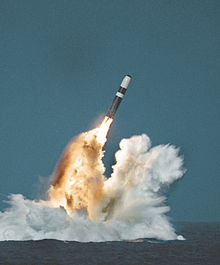Ballistic missile
A ballistic missile is a type of missile. It is only powered when it is launched. The power from its upward launch gives it all the energy it needs to get to its target. Most of its flight is not powered. Short-range ballistic missiles stay in the Earth's atmosphere. Intercontinental ballistic missiles (ICBMs) are launched into space but fall back down to Earth.[1] Both of them do not need the engine always on since in space and high in the atmosphere there is almost no wind resistance.

Ballistic missiles are different from cruise missiles, which have powered flight, move only in the atmosphere, and move aerodynamically. Imagine a cruise missile as a pilotless plane with a bomb flying low through the sky, while a ballistic missile is like throwing a dart with a bomb high into the sky to hit a target far away.
References[change | change source]
- ↑ Wragg, David W. (1973). A Dictionary of Aviation (first ed.). Osprey. p. 53. ISBN 9780850451634.
- Needham, Joseph (1986). Science and Civilization in China: Volume 5, Chemistry and Chemical Technology, Part 7, Military Technology; the Gunpowder Epic. Taipei: Caves Books.
Further reading[change | change source]
- Futter, Andrew (2013). Ballistic Missile Defence and US National Security Policy: Normalisation and Acceptance after the Cold War. Routledge. ISBN 978-0-415-81732-5.
- Neufeld, Jacob (1990). The Development of Ballistic Missiles in the United States Air Force, 1945–1960. Office of Air Force History, U.S. Air Force. ISBN 0-912799-62-5.
- Swaine, Michael D.; Swanger, Rachel M.; Kawakami, Takashi (2001). Japan and Ballistic Missile Defense. Rand. ISBN 0-8330-3020-5.
Other websites[change | change source]
- Missile Threat: A Project of the Center for Strategic and International Studies
